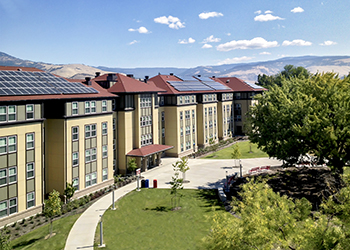Oregon School Sells Carbon Credits to Chevy
 ASHLAND, Ore. — Southern Oregon University (SOU) is taking part in Chevrolet’s carbon-reduction initiative. The school is selling carbon credits for the new LEED certified Raider Village residence halls to the car manufacturer for one year.
ASHLAND, Ore. — Southern Oregon University (SOU) is taking part in Chevrolet’s carbon-reduction initiative. The school is selling carbon credits for the new LEED certified Raider Village residence halls to the car manufacturer for one year.
While Chevy gets bragging rights for its eco-friendly initiatives, SOU gets money to reduce its campus carbon footprint.
“Chevy’s efforts offer an exceptional opportunity to recognize top-performing, LEED-certified projects, while encouraging them to continue to operate in ways that reduce greenhouse gas emissions and help mitigate global climate change,” said Chris Pyke, vice president of research for the U.S. Green Building Council (USGBC), in a statement.
SOU adopted a Climate Action Plan in 2010. The plan outlines the university’s goal to reduce its carbon footprint 10 percent by 2020 and 100 percent by 2050. One of its strategies to reach carbon neutrality is investing in green buildings, such as the LEED Gold-certified Raider Village. The buildings feature daylit common spaces, variable refrigerant flow technology and 153 kilowatts of solar photovoltaics.
In 2010, Chevy set carbon goals of its own, aside from just striving to make efficient vehicles and practice responsible manufacturing. The automotive giant set out to reduce up to 8 million tons of carbon dioxide in certified carbon projects across the country. To achieve this commitment, the Chevy rolled out a “carbon-reduction initiative.” The company announced it will be investing $40 million in projects that help reduce the amount of carbon dioxide in the atmosphere.
Among other projects, Chevy is purchasing carbon from campus greenhouse gas reductions and retiring them, meaning the company will never use them to offset emissions related to its own operations or products.
Chevrolet and SOU first connected on this project during a conference last year. During the program’s validation process, SOU discovered that certain LEED buildings were not performing to their full potential. This is a common problem for building efforts, which only focus on design and construction, and one of the reasons LEED increasingly emphasizes the need to link project goals with operational performance measures. Once aware of the opportunity for improvement, SOU engaged the student residents to help reduce energy use to achieve the buildings’ optimal performance.
“Discovering that the buildings weren’t performing to the design standards was just the push we needed to ramp up our student engagement efforts in the residence halls,” said Roxane Beigel-Coryell, sustainability and recycling coordinator at SOU, in a statement. “It also underlines the importance of monitoring all campus buildings to ensure they are operating as efficiently as possible.”
This fall, SOU students will be running an energy conservation campaign in the new halls to educate and engage residents about the university’s conservation efforts.
“We know there are ways to fuel the clean-energy movement beyond our electric vehicles and use of renewables at our manufacturing facilities,” said David Tulauskas, director of sustainability at General Motors, in a statement. “The leaders in the higher education community, like Southern Oregon University, are doing big things to leave a smaller footprint, and engaging their students along the way. This effort supports their ingenuity and continued investment in energy efficiency.”
SOU plans to use revenue from the carbon transaction to fund additional energy conservation projects on campus, such as lighting retrofits, equipment upgrades, or to expand existing solar arrays.
“SOU will further its clean energy leadership through this partnership with Chevrolet,” said Dr. Roy Saigo, president of SOU. “The funds gained will be reinvested in carbon-reduction projects on campus that will brighten the future of our students and benefit our community.”
